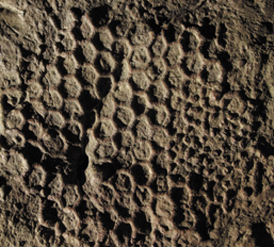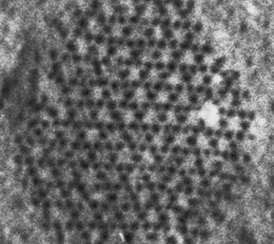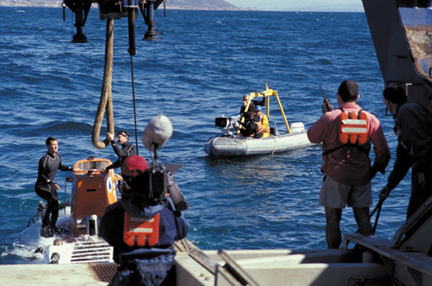Geotimes

Technology
Lighting the
Mysteries of the Abyss
Christina Reed
Puzzling photographs
In the summer of 1976, Peter Rona, then with the National Oceanic and Atmospheric
Administration (NOAA), sent a camera 3,700 meters below sea level to photograph
the Mid-Atlantic Ridge, as part of his Trans-Atlantic Geotraverse (TAG) project
near 26 degrees north latitude. While photographing basalt steps that make up
the eastern wall of the rift valley, he imaged a curious pattern in the overlying
sediment: tiny holes that looked like the impression of the hexagonal center
of a miniature Chinese checkerboard. The pattern, so small it could fit under
a poker chip, appeared randomly scattered across the sediment. Whatever creature
formed this pattern remained elusive.

 In
1978 — a year after the discovery of hydrothermal vents and their wild
communities of tubeworms, crabs and mussels in the Pacific — Peter Rona
and his colleague George Merrill, also then with NOAA, published the photos
in a report that categorized the pattern as belonging to an invertebrate of
uncertain identity.
In
1978 — a year after the discovery of hydrothermal vents and their wild
communities of tubeworms, crabs and mussels in the Pacific — Peter Rona
and his colleague George Merrill, also then with NOAA, published the photos
in a report that categorized the pattern as belonging to an invertebrate of
uncertain identity.
The report put the whodunit question to the geoscience community.
Left: Parts from a Chinese Checkerboard
lost at sea in the Atlantic? No, but this underwater photo (actual size: 5 centimeters)
taken in 1976 and first published in the April 1978 Bulletin of Marine Science
has become a fascinating challenge to identify. Right: The same puzzling pattern
shot with HDTV in 2001. Just what created this feature remains a mystery, but
one theory links it to trace fossils from the Eocene. The Stephen Low Company.
When paleontologist Adolf Seilacher of Tübingen University in Germany saw
the report in the Bulletin of Marine Science, he recognized the pattern
immediately and contacted Rona. The pattern looked to Seilacher like surface
features he had modeled for an ancient creature known only by its tunneling
trace fossil: Paleodictyon nodosum. That s pecies left a meshwork of
tunnels in the deep-sea turbidities of the Eocene and is part of a group of
similar trace fossils that date back to shallow, marine deposits from the Cambrian.
Formed a few millimeters below the sediment, the fossilized tunnels included
shafts to the water above.
In 1985, Rona led the discovery of the first hydrothermal vents in the Atlantic
in the same area, which is now known as the TAG hydrothermal field, and has
made more cruises to study the region and the mysterious pattern. He has shared
his observations with Seilacher and the two of them are piecing together the
evidence. But they needed better images.
Lights on!
The ocean is constantly surprising researchers with unusual features, animals
and geologic wonders that exist beyond the reach of sunlight. Submersibles
equipped with lights, cameras and humans can illuminate the scene, record the
drama and return with stories of deep-sea adventure. Advances in technology
allow these stories to grow richer with details and better understanding. Increasingly,
the public is able to share in the experiences of scientific explorations through
the use of ship-to-shore online communication and the Web.
 In mid-June 2003,
almost 27 years after Rona and colleagues took the first pictures of what may
be signs of a “living fossil” relative of Paleodictyon, this mystery
and other fascinating stories from the ocean’s depth will debut on a large-format
IMAX screen. After more than 10 years in the planning, the film Voyage into
the Abyss is scheduled to hit IMAX theaters around the world beginning next
fall.
In mid-June 2003,
almost 27 years after Rona and colleagues took the first pictures of what may
be signs of a “living fossil” relative of Paleodictyon, this mystery
and other fascinating stories from the ocean’s depth will debut on a large-format
IMAX screen. After more than 10 years in the planning, the film Voyage into
the Abyss is scheduled to hit IMAX theaters around the world beginning next
fall.
“Besides being visually spectacular, IMAX provides invaluable scientific
documentation of a geologic setting and its related ecosystem,” Rona says.
“When we go out in the field, whether on land or at sea, we are there only
for a short time to make observations. To be able to bring those observations
back at the resolution of IMAX, ultimately the best resolution for images, is
an invaluable record for the present and the future.”
Researchers prepped the Woods Hole Oceanographic
Institution's Alvin submersible for recovery after a dive in the Pacific.
Cameramen record the action for the IMAX movie Voyage into the Abyss.
Photo courtesy of The Stephen Low Company.
During the IMAX filming of the R.M.S. Titanic in 1991, the team of scientists
and filmmakers envisioned an IMAX exploration of hydrothermal vents. Leaders
in the oceanographic community supported the idea of an IMAX film for many years.
They emphasized to the National Science Foundation (NSF) the film’s potential
to showcase deep-sea research to the public and provide the scientific community
a never-before-attempted opportunity to film large-format IMAX imagery and high-definition
television (HDTV) under unparalleled lighting conditions. But it was Richard
Lutz of the Institute of Marine and Coastal Sciences at Rutgers State University
who committed scientific dives to the project and stepped forward as the science
director.
In 1999, in cooperation with Rutgers and with $100,000 from NSF, the team of
filmmakers, scientists and engineers from Canada and the United States prepared
the Woods Hole Oceanographic Institution’s Alvin submersible for a proof-of-concept
dive in the Pacific. While producer Stephen Low had used Russian Mir submersibles
to film Titanica, the Alvin, with its experienced crew of hydrothermal vent
explorers and extensive number of dives at vent systems, was the best choice
for Voyage into the Abyss. But “the Alvin is a whole different game, it
doesn’t have half the power available as the Mirs,” Low says. “We
needed a different lighting strategy using more lights instead of a handful
of big ones.”
On the Alvin, “we ended up using 10 smaller lights instead of four big
ones and installed new booms to get the lights high and far out into the water
column,” Low says. Outside the submersible, Alvin’s lights were moved
onto two double-articulating booms. When fully extended, the booms measured
more than 6 meters, making the sub difficult to maneuver, says pilot Pat Hickey.
The lighting technology developed for the shallow, underwater sets on James
Cameron’s 1989 movie The Abyss raised the bar for underwater photography.
Rather than standard fluorescent or incandescent lights, Cameron had relied
heavily on mercury-halide discharge lamps called Hydragyrum Medium arc-length
Iodide, or HMI, which are four times more powerful. But their watertight casings
were made for depths around 20 meters. Low modified the casings and lights for
his 1992 IMAX documentary of the R.M.S. Titanic. When Cameron went to shoot
Titanic the movie, Low in return lent him the modified lights capable of 4,000-meter
depths.
HMI lights are now standard equipment for deep-sea photography. “We used
all of Alvin’s inventory of HMI lights, plus a few more brought by the
IMAX film crew,” says pilot Blee Williams. They attached one 1,200-watt
HMI to a modified manipulator arm normally used to collect science samples.
“Usually a pilot will burn two 400-watt lights, and that is enough for
driving, sampling and video. During the IMAX dives we often burnt 10 of the
400-watt HMIs and the 1,200-watt HMI, which provided about 16 times the light
an Alvin pilot normally has to work with. As I drove around the seafloor I could
see 50 meters and even beyond if the target was in high contrast to the background.
A vast improvement over the 8 to 10 meters I can see with my usual array of
lights.”
Or, as Low says, it’s the difference between lighting the Houston Astrodome
or lighting a small bathroom.
The dive proved successful and in January 2001, NSF agreed to fund Voyage into
the Abyss. “The biggest challenge was raising the funding,” says Alex
Low, executive producer and marketing director for his brother’s company.
“The film cost $7 million plus a million dollars in dive time, so, on the
whole, $8 million.” NSF provided approximately $2 million of that, he says.
Rutgers provided another $1.5 million. Additional support came from the New
England Aquarium in Boston, and from The Stephen Low Company.
The team moved on to the Atlantic where the TAG, Lost City and Snake Pit hydrothermal
vent fields awaited. From the Pacific dives they knew some additional equipment
would be needed to help the Alvin pilots. To fit through Alvin’s hatch,
the IMAX camera needed to be disassembled and then reassembled during descent.
Installing the 150-pound camera into Alvin took up the room of one person in
a submersible made for three. This squeeze left just enough space for a pilot
and a cameraman. Unfortunately for the pilot, the camera lens looked directly
out the front porthole intended for navigating. And coincidently both the porthole
and lens were the same size — about 4 inches in diameter.
“At first Bill [Reeve, director of photography] and I shot some rock walls
and a giant anemone while I figured out how to drive Alvin looking out the side
window, instead of the front,” Williams says of his dive in the Pacific.
“The light booms stuck way out and getting used to just where they were
in relation to what I could see took a can of film or two.” To compensate
for the lack of visual perception out the front, three small video cameras were
attached on the outside of the submersible that sent a panoramic view to three
small LCD (liquid crystal display) monitors inside.
“The pilot had these monitors arranged in such a way that, as the camera
person directed the pilot to move around the shot subject, he was able to drive
the sub with the monitors seeing more than 180 degrees around the front of the
sub,” Hickey adds. “The drawback of this arrangement was that the
pilot had no depth of field and so had to exercise extreme caution to prevent
contact with some of the structures being filmed.”
The team encountered a few shots too close for comfort. The hydrothermal vents
often reached temperatures of 400 degrees Celsius, hot enough to melt lead.
“We came back several times with burns,” Stephen Low says. “We
burned a big swath in the fiberglass side of the hull. We sand it down, paint
it and go back down. That’s the nice thing about fiberglass.”
In the summer of 2001, the Alvin dove 16 times along the Mid-Atlantic Ridge
and twice revisited the TAG hydrothermal field where the mysterious pattern
was first caught on film in 1976. In order to catch the details of the surface
form, Rona, who has worked at Rutgers since 1994, and National Geographic photographer
Emory Kristof left the IMAX camera on board the R/V Atlantis and dove with a
pilot of the Alvin to film the pattern using the Woods Hole HDTV camera, which
captures close-up images. Although the IMAX camera is best for vista shots and
the panoramas of the vents and their communities, Woods Hole collaborated with
IMAX to record the shrimp eyes and other close-ups with HDTV.
Under the extra bright lights and in close-up detail, the surface relief of
the mysterious Chinese checkerboard-like forms appeared in clear view with nobs
of sediment piled between definite holes, which had before seemed somewhat ambiguous.
The new data about the nobs of sediment between the holes sent Seilacher into
thrills of excitement. He suspects the patterns are from a submerged tunnel
system that acts like a garden of bacteria for whatever creature made it. Although
past core studies of this material turned up negative for organic material,
Seilacher thinks that the holes act as sinks for the water flow above the pattern
and the nobs represent the areas where the sediment has circulated out of the
hypothesized sub-seafloor, chicken-wire meshwork of tunnels. “What we find
in the fossil record is not tunnels, but casts of them,” he says. In the
modern analog, “now we have the interesting detail of the sediment surface.”
But just what created this pattern remains aloof from the lights of Alvin.
Reed is associate editor of
Geotimes. E-mail her at car@agiweb.org.

 In
1978 — a year after the discovery of hydrothermal vents and their wild
communities of tubeworms, crabs and mussels in the Pacific — Peter Rona
and his colleague George Merrill, also then with NOAA, published the photos
in a report that categorized the pattern as belonging to an invertebrate of
uncertain identity.
In
1978 — a year after the discovery of hydrothermal vents and their wild
communities of tubeworms, crabs and mussels in the Pacific — Peter Rona
and his colleague George Merrill, also then with NOAA, published the photos
in a report that categorized the pattern as belonging to an invertebrate of
uncertain identity. 
 In mid-June 2003,
almost 27 years after Rona and colleagues took the first pictures of what may
be signs of a “living fossil” relative of Paleodictyon, this mystery
and other fascinating stories from the ocean’s depth will debut on a large-format
IMAX screen. After more than 10 years in the planning, the film Voyage into
the Abyss is scheduled to hit IMAX theaters around the world beginning next
fall.
In mid-June 2003,
almost 27 years after Rona and colleagues took the first pictures of what may
be signs of a “living fossil” relative of Paleodictyon, this mystery
and other fascinating stories from the ocean’s depth will debut on a large-format
IMAX screen. After more than 10 years in the planning, the film Voyage into
the Abyss is scheduled to hit IMAX theaters around the world beginning next
fall.